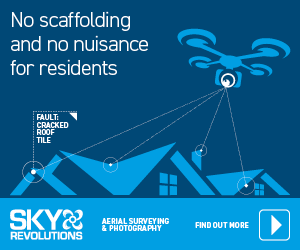Traditionally, councils (and many others) undertake roof surveys and property condition reports for housing stock manually, with scaffolding erected around each property – allowing for human inspection.
Programmes of this scale can last anything upwards of a year, depending on the portfolio.
They can be intensive in terms of staff hours, and costly, and they can also be a nuisance for residents – particularly in the summer months when scaffolding can prevent window-opening.
For local authorities, finding partners who can offer significant cost efficiencies without impact on quality is critical. One solution is to deliver surveys by drone using aerial specialists Sky Revolutions.
This approach entirely negates the need for scaffolding, removes nuisance to residents, cuts down on the time needed to undertake surveys, delivers detailed data much quicker and, importantly, massively reduces inspection cost.
In the financial year 2020-21, English housing associations alone spent a combined £5.4 billion on repairs and maintenance.
An FOI request by MyJobQuote revealed responses from 244 UK councils showing that on average, spend on responsive repairs and maintenance averaged £8,173 per house in the year 2020-21, placing considerable demand on council budgets – at a time when pressure on the public purse has never been greater.
Drones offer significant savings on traditional surveys, and these are likely to be even higher when factoring in the reduced nuisance to residents.

As well as having to keep windows shut in places, residents face an increased security risk and concerns relating to fire hazard – increasing anxiety for residents and placing a heavy burden on back-office admin in resident communication management.
Sky Revolutions Managing Director Ben Gorham says: “Accurate observation is key in our markets.
“We’re often tasked with working in tricky, hard-to-reach areas, and sometimes sites can pose logistical or safety challenges. This means we need to be incredibly efficient in gathering the data our clients need.
“Directing our drones to the point of interest quickly and safely is critical. Our building and asset inspection software platform lets us systematise image content efficiently, meaning we spend more time highlighting the issues for our customers and less time organising the data – as the platform does much of that hard work for us.
“This double efficiency is of massive benefit to our clients.”
Only specialist commercial operators with the right permissions for flying in populated areas can undertake these types of aerial surveys in inner cities.
But coupled with this expertise is the knowledge to translate what you’re seeing into actionable data.
Sky Revolutions has built their drone expertise on top of solid construction experience, meaning they have a head-start in understanding what their drones can see.
Ben Gorham again: “I’ve instilled construction knowledge in my team here at Sky Revolutions, recruiting and training team members and pilots to spot remediation issues from height.
“Whether we’re looking at roofs, wind turbines, powerlines or telecom towers – customers have faith in our ability to get to the heart of the matter quickly and present that data to them clearly.”
Sky Revolutions’ pilots are professional commercial operators with permission to work in built-up areas.
The cost, speed and safety benefits of using drones to survey are slowly trickling through to the complex housing management sectors.
Moving away from long-entrenched methods of inspection can take time, but as we evolve to make better use of tech, so the benefits are beginning to be more widely shared.
- To find out more, please visit www.skyrevolutions.co.uk/local-authority or call 01778 560929